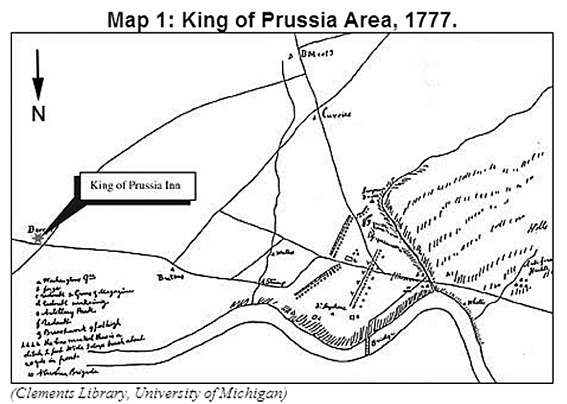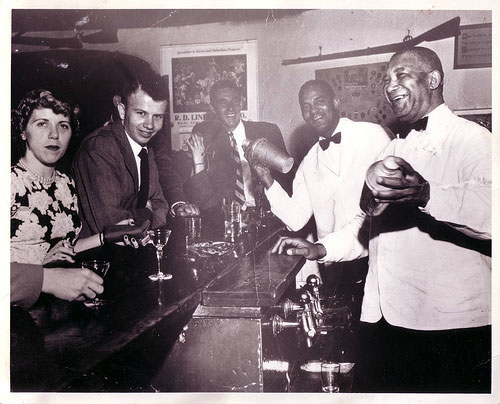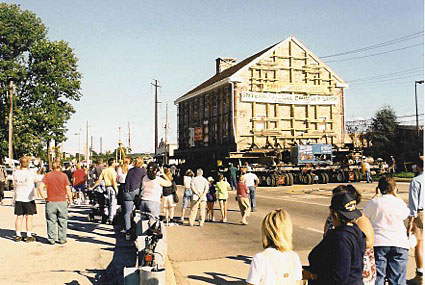
 |

King of Prussia Inn
|
|
At the Sign of the Kingby J. Michael Morrison (from his book King of Prussia-Images of America) |
|
|
No icon better represents King of Prussia than the King of Prussia Inn. The practice was to tell someone to meet “at the sign of the King”, later simplified to just “the King”. The “Parker Spy Map” drawn in 1777 by British spy William Parker, is a detailed rendering of the area where George Washington was encamped. A portion of the map seen here includes the King of Prussia area, which was a haven for spies from both sides. The Inn is referred to as “Berry's,” named after the proprietor and licensee at the time, James Berry. Swedesford Road (US 202) is also included on the map, and dates as far back as the 1680s.  “The Sign of the King” welcomed visitors for almost 200 years, and may have been the source for the town receiving its name. Although the year 1709 is clearly written on the sign, no proof exists that there was an inn there. In addition, the image represents Frederick the Great (1712-1786), who was a powerful ruler in 1769. The sign was sold in 1920 to a resident of Philadelphia for $200, amid growing resentment for Germany with the advent of WWI. The sign was finally recovered from an auction in 1960 by Lucressa Morrison, a local antiques dealer, and returned to the King of Prussia Historical Society, in whose hands it is still entrusted today. William Rees, partially converted his farmhouse into a tavern in 1769, which continued as a public house through over half of the 20th century. Records of this time period are sketchy at best. The earliest reference to the Inn is a tavern license issued to Philip Rees in 1762. The earliest reference to the land appears in a deed recital “under the hands and seals of Rees Thomas and James Logan dated November 16, 1714”, however, there is no evidence of a tavern existing there at that time. An 1893 map of Upper Merion reveals a cluster of buildings around the Inn. These buildings consisted of a stable, carriage house and storage shed. In 1902, George W. Holstein wrote of a conversation he had with Charles S. Elliott, son of John Elliott Jr., who owned the Inn from 1841-1868. “He [C. Elliott] thought it [King of Prussia] commanded a position which should make it valuable as a business center and attractive as a place of residence.” How prophetic those words would be. Charles Francis Saunders, in Country Walks in 1889 wrote of the inn, “The landlady [Madeline B. Hoy], a buxom widow of 45, meets you at the door and invites you in. An old fashioned clock ticks in the hall and the floor slants invitingly to the sitting room with its low ceiling and broad window seats.” “The meals are of the country kind-plain, well cooked and substantial and apt to terminate in three kinds of pies. If you come to supper you will probably have waffles, than which a no pleasanter fate can befall you. The kitchen which supplies the tables with the delectables referred to is one of the kind you read about-the big old fireplace and the crane and the ceiling ribbed with smoky rafters.” At the beginning of WWI, the Inn was renamed “The Old King Inn” for a time, due to over whelming anti-German sentiment. According to Senator Philander C. Knox in a letter dated August 9, 1918, “A few patriotic citizens a few nights ago shot up the old sign-board of the King of Prussia Inn, and I believe that citizens who reside in the neighborhood are no longer registering themselves as from King of Prussia.” For a short time there was even talk of changing the name of the town. In fact, a newspaper report of the time tells that “the people asked to consider the name change of King of Prussia because of the resemblance of the name to that of a recent warring country and to change the name to Port Kennedy (a close neighbor), which is more suitable .” In 1920, Anna Heist Waters purchased the Inn with her husband Thomas and operated it for the next 32 years. These are copies of two of Mrs. Waters' favorite recipes for peaches. During Prohibition, only a restaurant could be conducted at the Inn, with the specialty of the house being Beefsteaks, later called Steak Sandwiches, served open faced over bread with a delicious mushroom sauce. With the repeal of Prohibition in 1933, the bar was reopened and a new house specialty, the mint julep became quite popular, served by a stately gentleman known only as Williams. At least two guidebooks of the era mention the Inn as a worthwhile stop. Many notables also visited the Inn during its lifetime. Bob Hope was said to have dined there, as well as Senator Barry Goldwater. Local advice at the time reported that for anyone looking for his doctor should “call the K of P Inn, he'll be there .”  An ad for the King of Prussia Inn from the early 20th century states that “Washington and his officers more than once held Masonic Lodge” at the Inn. It has even been speculated that General Lafayette was inducted into the Masons there. It is also known that Jefferson, Madison and Monroe took refuge there to escape the yellow fever epidemic of 1793. In 1952, the PA Highway Dept. made plans to change US 202 from a two-lane macadam road to a four lane divided highway from Norristown to West Chester. The plan called also called for the demolition of the inn. Mrs. Waters determined to keep her business going, decided to move to another location. She found the perfect place in Jeffersonville, but poor health forced her to close less than ten years later. By 1953, condemnation of the Inn was completed and PennDOT purchased it for $139,000. In 1955, a group of local citizens headed by local pediatrician Dr. Robert May formed “The Committee to Save the Inn”, shortly thereafter known as the King of Prussia Historical Society. They convinced PennDOT to reroute the highway and save the Inn, unfortunately however marooning the once magnificent hostelry on an isolated island of concrete. This picture from 1955 shows the inn looking north and east on US 202. Now the Inn, deserted and unreachable, fell into disrepair and became the object of vandalism. In 1960, the Inn was registered with the Historic American Building Survey, and in 1967, Jack Shain raised $800 for repairs, but after some work was completed, funds ran out and an electrical fire in the basement caused extensive damage, stopping work altogether. Panic set in through the community with the approach of 1976 and the nation's Bicentennial. Local businessmen helped the effort by contributing to the revitalization of the Inn, and it is said that it was the repointing of the stone with portland cement that held the building together for another 25 years. The King of Prussia Inn is seen isolated between two lanes of US 202 in this photo from the late 1960s. Notice how close the southbound lane of the highway came to the front door, rendering access impossible. Many plans to use the site for historical and educational purposes were conceived and soon abandoned as impractical. Furthermore, the need for additional highway expansion made it necessary to again contemplate the permanent removal of the building.  On Sunday, August 20, 2000 the King of Prussia Inn, a 580 ton structure, was finally moved to its new home one half mile away to the east. Under the watchful eye of the Chamber of Commerce, contributions from local businesses and interested residents as well as federal, state, and local governments, made it possible to save this landmark structure, after sitting idle for over 50 years. New regulations put in place in the late 20th century provide for more careful planning to stay away from historic structures completely. The King of Prussia Inn now resides at 101 Bill Smith Blvd., The building is now used as offices, and is the headquarters for the Montgomery County Chamber of Commerce and the King of Prussia Historical Society, which share its ownership. This is not the end of the story of the story of a building that is almost 300 years old, but a new beginning for the Inn and for the community, past, present, and future. |
|
|
Page last updated: 2012-05-28 at 12:05 EDT |